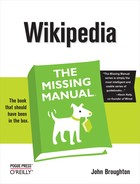Inserting an external link into an article to show where you got information is better than nothing, but by itself it’s not the proper way to cite a source. An embedded link (an external link in the middle of an article) isn’t a proper citation because links, like milk, have a tendency to go bad over time. Links can stop working when a Web site goes out of business, someone moves or deletes a Web page you linked to, or a URL changes for any number of reasons. When links go bad, so does any substantiation of the sentences that the links were supposed to support.
Note
The general problem of links going bad is called link rot. A non-working link without any other information is almost worthless. Page 349 discusses some ways to try to fix a bad link.
The best way to reduce the impact of bad links is to fully cite your source, to include more information than just the URL.
Currently, Wikipedia lets you use one of the three different methods for a proper citation. All three use a “References” section at the bottom of the article.
Embedded citations. You put an embedded link into the article (as described earlier), and then put the same URL, plus additional information about the source, into the “References” section. For details on this method, go to WP:ECITE.
Footnotes. You add all the source information into the body of the article, plus special footnote markup. When the Wikipedia software displays the article, it puts a footnote number in the body of the article and the citation information in the “References” section at the bottom. When readers click a footnote number, it takes them to the footnote information at the bottom of the article. (You can learn exactly how to create footnotes starting on 1; also check out WP:FOOT.)
Parenthetical referencing. You put the citation’s cross-reference information (author, year of publication, and page number) into the body of the article, and also put that information, plus the title of the article or book, the name of the publisher and other publication information into the “References” section. If you use templates (which isn’t required), then the information in the body of the article is linked to the information in the “References” section. If you use only plain text, then the two aren’t tied together by the software. (For details, go to WP:PAREN for an example.)
How do you choose among the three citation methods? If you’re working on a new article, or expanding an article that uses none of these methods, that’s easy. Use footnotes for the following reasons:
The embedded citations approach can’t handle offline sources—those for which there’s no URL, even though offline sources are perfectly acceptable in Wikipedia. Don’t use it.
Parenthetical referencing, in the format described above, is used in only a very small percentage of Wikipedia articles—well under five percent. Moreover, there are a number of variants of Harvard citations, both for the way text shows in articles and for the underlying templates of the system, so learning this method takes more time. Plus it’s often mixed with regular footnotes, as in the article Dionysus.
If an article already uses a method other than footnotes, you have two options:
If the article has embedded citations, convert them to footnotes. Embedded citations are a legacy from before Wikipedia had footnotes. It’s actually less work for an editor to do a regular footnote than to do an embedded citation, so if you do the work of converting to regular footnotes, other editors will be happy to do footnotes thereafter.
If the method is Parenthetical referencing and you want to add information to the article, you must use that method. Don’t get into a fight about footnotes being better— once a style is in place in an article, leave it as is.
As you’ll discover as you edit Wikipedia, getting all editors to do everything the same way is like trying to herd a group of cats. It’s best to take what the cats prefer to do into account. Wikipedia has policies, which everyone must follow; guidelines, which sometimes provide multiple options; and some things on which there’s never been general agreement, so there aren’t even guidelines. In practical terms, footnotes fall into that last category.
For example, a survey of 28 Main Page articles in October 2007 found that 12 articles used only regular footnotes, while five used only footnotes in the parenthetical style. The other 11 articles used a mix of the two. Even then, there wasn’t just one style: eight of the 11 used two sections, but three combined the two different footnotes into a single section.
In general, you’ll find footnotes appearing in two different ways in fully developed articles:
Regular footnotes. A footnote number appears in the body of the article, and the full citation information for that footnote appears at the bottom the article, in a section usually (but not always) called “References.”
Author-date footnotes. A footnote number in the body of the article links to a brief citation (author plus page number, or author plus date plus page number) in a “Notes” section. Then full citation information goes in a second section called “References.” There’s no automated connection for the reader between text in the two sections.
Since footnotes in the parenthetical style are a variant of regular footnotes, once you’ve learned regular footnotes, you’ll have no problems with the variant. Don’t get into a fight over the “right” way to do footnotes. If you’re creating or building an article, you can pick a style that suits you; if you’re adding to an article with an established style, follow that style.
